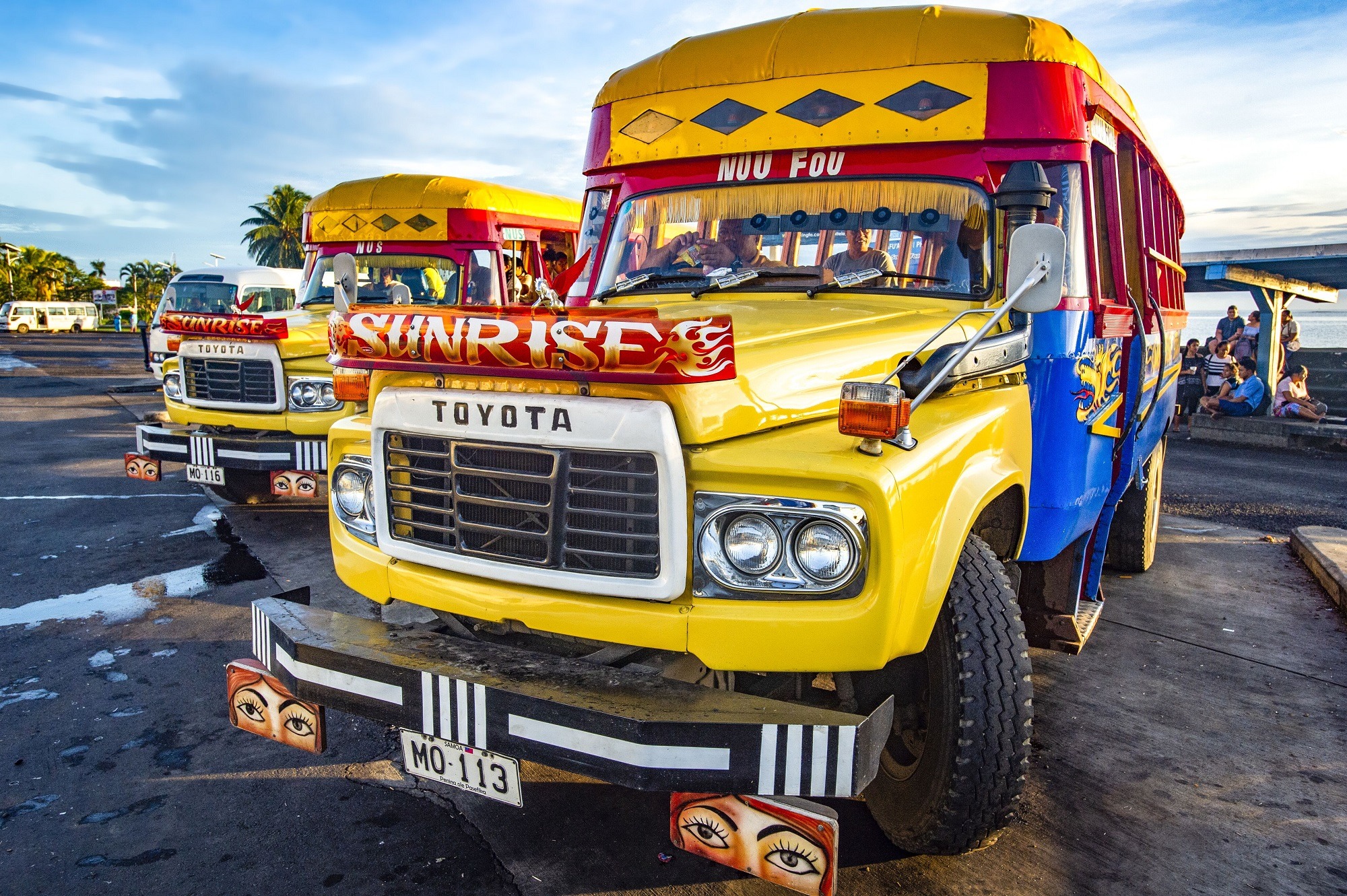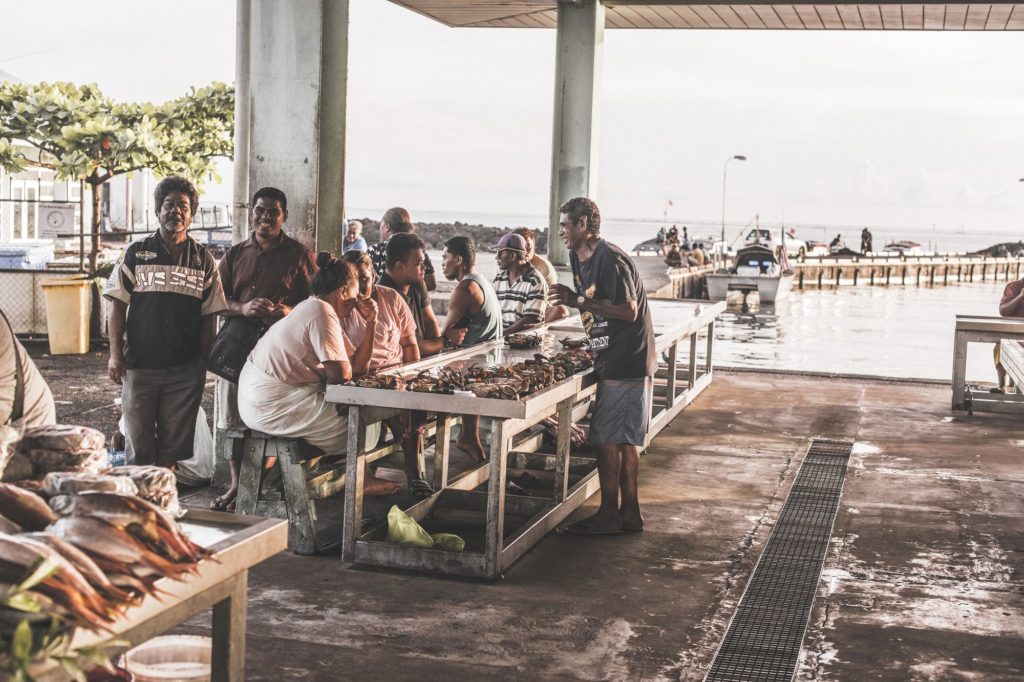Samoa
Brushing Bottoms On Samoa’s Buses
Fiona Harper gets up close and personal with some large Samoans on their uniquely colourful buses but reassured by their names expressing Christian sentiment she carries on regardless to wherever it is she wants them to take her.
December 14, 2019
Fiona Harper
December 14, 2019London has its ubiquitous taxi cabs and tube, New York, has the subway, San Francisco’s vertigo-inducing streets rumble with cable cars while Bangkok’s roads are besieged with tuktuks tooting and touting for attention.
Then there is Apia. Capital of Samoa and serious contender for one of the world’s most relaxed capital cities, Apia’s public bus system is as colourful as they come.
There is no chance of not seeing, nor hearing, Samoa’s public buses as they rumble along oft-rudimentary roads of the capital or the ring road that circles the big island of Savai’i.
Public buses come wholly pimped, some more so than others. Buses come with trailing flames across the bonnet over the roof and down each side. Others are entirely swathed in air-brushed murals with thoughtful messages emblazoned on their flanks. Some of these remind me of those ‘shaggin wagon’ panel vans from the 1980’s my parents warned me to stay away from. You know the ones that had bikini clad women on tropical beaches framed by palm trees whose male owner’s intentions were questionable? The Samoan version however is far less risqué and more Christian in intent.

These clunkers are mostly decades old and are built neither for speed nor comfort. The old-fashioned kind with protruding squarish bonnets and windows removed, their diesel engines can be phlegmatic and flatulent. All come with their own unique signwriting, none of which gives any indication of the bus’s actual route or destination. Some give a clue to driver’s religious leanings. Timetables are tightly held secrets that these same drivers seem reluctant to reveal. Particularly if you happen to make the mistake of waking a dozing driver whose bus is parked by the side of the road under a palm tree ‘Sunrise Transport’ sounds like a promising ride until I notice the driver peering out of a windscreen framed by long tendrils of lime green shagpile carpet, his own ample frame wedged between three men well enough proportioned to play front row for the national Samoa Sevens rugby side. I quite like the sound of ‘Blessings Transport’ and imagine bumping along to my destination and arriving bathed in the goodwill glow of fellow passengers.
Others promise ‘Paradise in Heaven’ and ‘Glory to God’ while another still assures me that ‘Jesus is the Way’ in large lettering above the Toyota badge on the bonnet. But I’m not certain I’m heading in that direction today.
I bypass ‘Storm Express’ and gravitate towards ‘Beyond the Blue’ which looks like an alluring cocktail with its faded scarlet bonnet, cornflower blue roof and window frames painted sunshine yellow. The only thing missing is a paper umbrella and a fragrant frangipani lei.
Meanwhile, ‘Lady Samoa’ beckons seductively with an image of a lithe woman draped in a floral sarong, a red hibiscus tucked behind an ear and lustrous locks cascading over bare shoulders. I wonder what the Christian missionaries would make of her come-hither expression.
Rear end panels are adorned with gothic creatures with skeletal frames peering from mysterious cloaks. Bumpers carry inspirational messages like ‘Be strong n stay humble’ or ‘Don’t give up. Try again bro’.
Onboard comforts are few. The seats are uncushioned pew-like wooden benches, ostensibly made to seat three or four, but Samoans tend to be plus sized so it’s virtually impossible to prevent your bottom from rubbing against another. There’s also a rather disconcerting practice that would probably have you arrested if you tried it in New York or London. As the bus fills up, people just sit on one another’s laps rather than stand in the aisle. It’s considered normal.

Friendly Samoans nearly always offer their laps to travellers or ladies burdened with bags of vegetables or a swaddled infant. It would be rude to refuse. Beyond a couple of bus stations, there are no designated stops – when you want to board, simply stand on the side of the road and wave the bus down. When you reach your destination, just pull the cord to ring the bell when you want the driver to pull over.
Apia’s downtown bus station is rudimentary. Raucous laughter rings out from a circle of men sitting cross-legged on the concrete floor playing cards. They seem oblivious to the coming and going of buses disgorging and collecting passengers. Their gazes are directed inwards before erupting with thigh-slapping hilarity as hands are revealed. They don’t seem to notice the women labouring with heavy loads of vegetables. Nor are they fussed by unruly kids running hither and thither between the buses or skittish dogs scavenging for scraps.
Mid-morning the bus station is abuzz. Above the sound of idling diesel engines a tinny-sounding ukulele rings out from a handheld radio. The open-sided pavilion is peppered with stalls selling soft drinks and snacks. Creamed coconut wrapped in taro leaves and baked breadfruit are popular.
Everywhere, people patiently await their ride, sprawled across tables, slumped in plastic chairs or sitting on the ground leaning up against a grubby wall. No-one seems perturbed by the interminable wait.
It’s true that it took some Samoans time to adapt after 2009 when the entire country switched from driving on the right hand side of the road to driving on the left. Some buses are yet to make the conversion, meaning you’ll board and disembark from the middle of the road.
But Samoans don’t get stressed or uptight about such inconveniences. In a country guided by Christian principles, where they are accustomed to walking, traffic mostly gives way to pedestrians. Can you imagine such a preposterous occurence in New York, London or Bangkok?
© 2024 Pacific Island Living Magazine all Rights Reserved
Website by Power Marketing